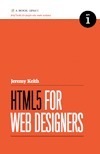What do you think?
Rate this book


First published May 4, 2010
The minimum information required to ensure that a browser renders using standards mode is the HTML5 doctype. In fact, that’s the only reason to include doctype at all. An HTML document written without the HTML5 doctype can still be valid HTML5.